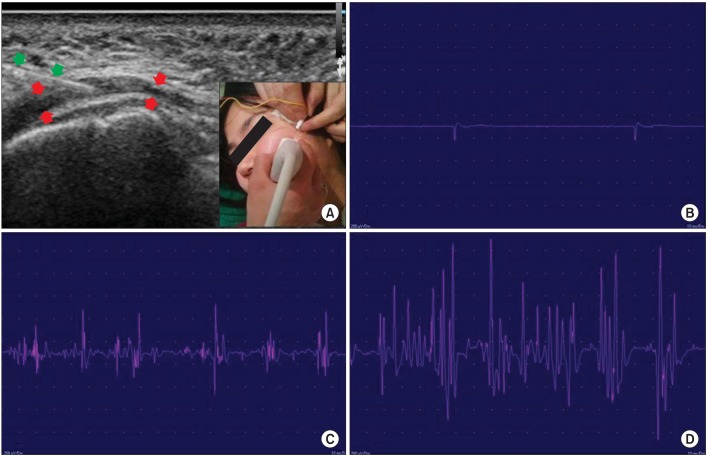Ann Rehabil Med.
2013 Jun;37(3):433-437. 10.5535/arm.2013.37.3.433.
Diagnosis of Zygomaticus Muscle Paralysis Using Needle Electromyography With Ultrasonography
- Affiliations
-
- 1Department of Rehabilitation Medicine, Korea University College of Medicine, Seoul, Korea. spinelee@gmail.com
- KMID: 2219543
- DOI: http://doi.org/10.5535/arm.2013.37.3.433
Abstract
- A 22-year-old woman visited our clinic with a history of radiofrequency volumetric reduction for bilateral masseter muscles at a local medical clinic. Six days after the radiofrequency procedure, she noticed a facial asymmetry during smiling. Physical examination revealed immobility of the mouth drawing upward and laterally on the left. Routine nerve conduction studies and needle electromyography (EMG) in facial muscles did not suggest electrodiagnostic abnormalities. We assumed that the cause of facial asymmetry could be due to an injury of zygomaticus muscles, however, since defining the muscles through surface anatomy was difficult and it was not possible to identify the muscles with conventional electromyographic methods. Sono-guided needle EMG for zygomaticus muscle revealed spontaneous activities at rest and small amplitude motor unit potentials with reduced recruitment patterns on volition. Sono-guided needle EMG may be an optimal approach in focal facial nerve branch injury for the specific localization of the injury lesion.
MeSH Terms
Figure
Reference
-
1. Roob G, Fazekas F, Hartung HP. Peripheral facial palsy: etiology, diagnosis and treatment. Eur Neurol. 1999; 41:3–9. PMID: 9885321.
Article2. Dumitru D, Amato AA, Zwarts MJ. Electrodiagnostic medicine. 2nd ed. Philadelphia: Hanley & Belfus;2002.3. Park YJ, Jo YW, Bang SI, Kim HJ, Lim SY, Mun GH, et al. Radiofrequency volumetric reduction for masseteric hypertrophy. Aesthetic Plast Surg. 2007; 31:42–52. PMID: 17235460.4. Park IY, Lee ME. A morphological study of the parotid gland and the peripheral branches of the facial nerve in Koreans. Yonsei Med J. 1977; 18:45–51. PMID: 617028.
Article5. Gray H, Standring S. Gray's anatomy: the anatomical basis of clinical practice. 39th ed. Edinburgh: Elsevier Churchill Livingstone;2005.6. Pessa JE, Zadoo VP, Garza PA, Adrian EK Jr, Dewitt AI, Garza JR. Double or bifid zygomaticus major muscle: anatomy, incidence, and clinical correlation. Clin Anat. 1998; 11:310–313. PMID: 9725574.
Article7. Satiroğlu F, Arun T, Isik F. Comparative data on facial morphology and muscle thickness using ultrasonography. Eur J Orthod. 2005; 27:562–567. PMID: 16135538.8. McAlister RW, Harkness EM, Nicoll JJ. An ultrasound investigation of the lip levator musculature. Eur J Orthod. 1998; 20:713–720. PMID: 9926638.
Article
- Full Text Links
- Actions
-
Cited
- CITED
-
- Close
- Share
- Similar articles
-
- Dose-dependent Responses to Botulinum Toxin A Injection on Compound Muscle Action Potential Amplitude and Electromyography: Local and Distant Effects
- Anatomical Basis of Pronator Teres for Electromyography Needle Placement Using Ultrasonography
- Diagnosis of Ilioinguinal Nerve Injury Based on Electromyography and Ultrasonography: A Case Report
- Morphologic Evaluation of the Flexor Carpi Radialis Muscle Using Ultrasonography for Accurate and Safe Needle Electromyography
- Progressive Muscular Atrophy with Hypokalemic Periodic Paralysis: A Case Report




